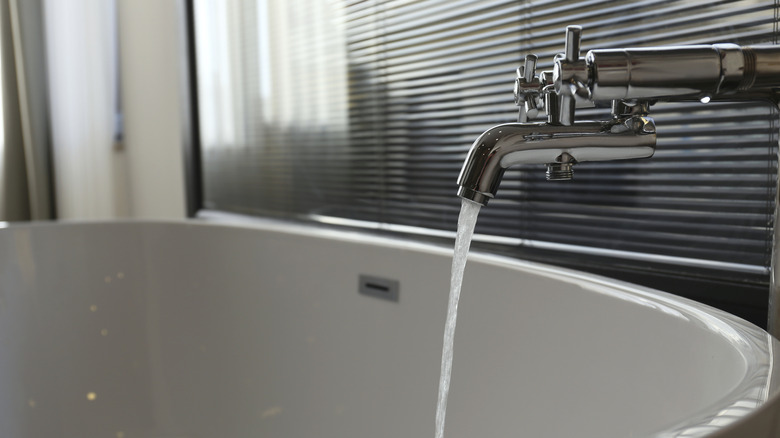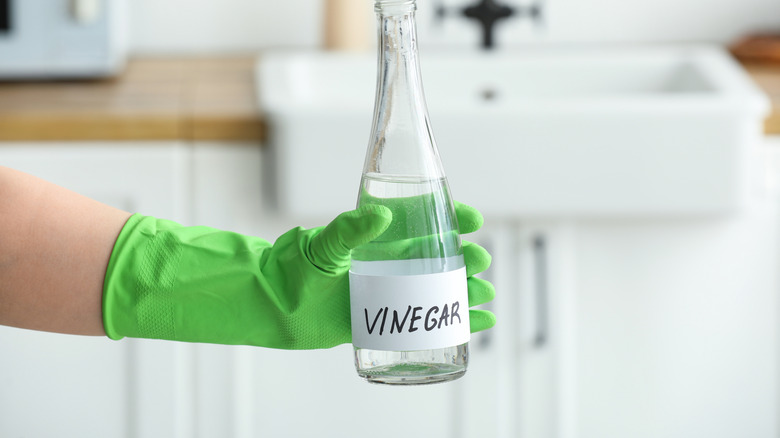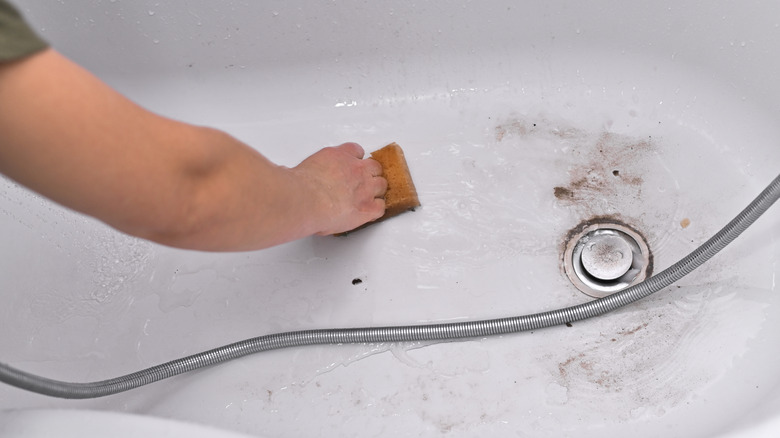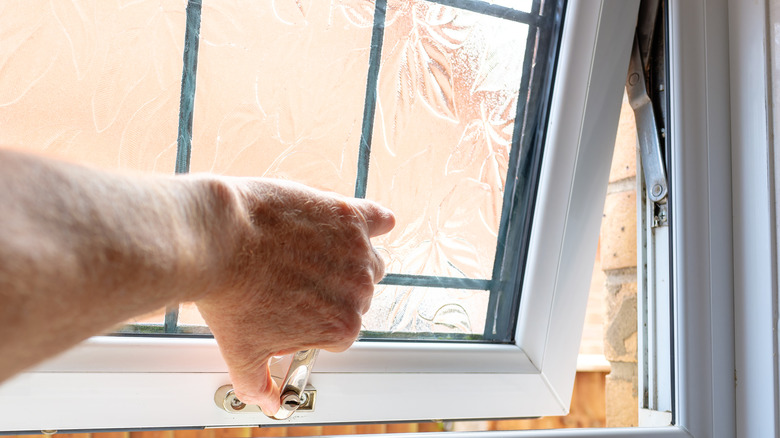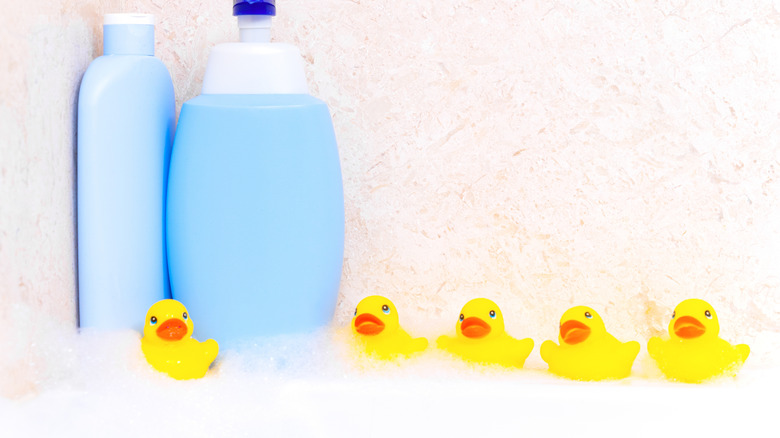Tips & Tricks To Help Maximize The Time In Between Bathtub Cleanings
Deep cleaning your bathroom is so satisfying, but maintaining your fixtures between these sessions is just as important. Nothing is more frustrating than a bathtub that gets grimy after only a few uses, and the effort required for a big scrub is exhausting and probably not something you want to do every week. If you're wondering how to stretch the time between deep cleanings, there are actually many tricks you can employ to help keep your fixture fresher for longer.
Keeping vinegar or mild cleaning sprays in your bathroom is useful and super easy, while regularly scrubbing areas that hold hard water stains will save you a lot of time down the line. Even simple habits like rinsing your bathtub with fresh water after it's drained will remove excess soap scum. You should also keep a scrubber handy (this could be a toilet brush or a similar tool) so you can take off any residue lurking on the sides of the container or drain, which can build up and calcify.
When it comes to how often you need to clean your bathtub, every day might sound excessive, but with a few habits after every use, you'll ensure its material stays crisp and clean. While skin cells, hair, body oils, and outside dirt and grime can collect on your acrylic, fiber glass, or porcelain, try these quick, simples tricks to remove them so they don't linger. Plus, your fixture will be nicer to use when you aren't bathing in old detritus.
Give your tub a rinse after every use
Rinsing your tub after every use seems like a no-brainer, but don't underestimate its benefits. The key is to let your tub fully drain, allowing all the soap and products to wash away. From there, you can either take a cup or any kind of jar or vessel and fill it with fresh water from the spigot. If you have a bath/shower combination, turn on the shower to allow the water to rinse your tub. Otherwise, use the cup or jar to pour water all around the edges of your tub where soap might be remaining that will eventually turn into soap scum.
You can also turn the tap on while you're doing this and use a microfiber cloth or even an old washcloth to help guide the water all around the interior of the tub. Allow the water to rinse and drain out completely again, then use a dry towel to give the interior a brief wipe to also remove any water stains. Do this after every bath or shower.
Vinegar or cleaning sprays help keep tubs fresh
Keeping a mild cleaner near your bathtub at all times means you have an easy way to remove everything from soap scum to water stains. Spills from your toiletry products can cake onto the sides or bottom of your tub, and the longer they're left to sit, the trickier they can be to eradicate. Dirt and grime can also accumulate just from daily interactions in your bathroom by floating off clothes, pets, and other items, including overhead vents.
Spray a cleaning product and wipe down your bath interior to leave it fresh for every use. You can find mild bathroom cleaners at your local shops, or you could make your own. DIY vinegar cleaning solutions are great for removing dirt and buildup, which add a stubborn layer to your tub if left too long. Combine three parts water with one part vinegar for this mixture, which can also be used to spot treat certain areas. Allow the cleaner to soak for at least 10 minutes before using a cloth or sponge to scrub. Baking soda combined with vinegar can also help for tougher stains, and it's a cleaning hack Martha Stewart swears by.
Keep a toilet brush or scrubber handy
Along with a good cleaner, keeping a scrubbing brush or tool that can help remove harder stains will make it easier to maintain the overall tub. While porcelain may be a little more sensitive to abrasive cleaning products, it is more resistant to scratches than fiberglass and acrylic. Regardless, be gentle when cleaning and avoid using rough scrubbers like steel wool. Using a toilet brush is a simple way to clear away any filmy layers of soap and remove those little particles, like skin cells and hairs.
If your body washes have exfoliating beads in them, the toilet brush or a similar product will help wash those toward the drain or pick them up off of the tub's interior. Make sure to purchase an extra scrubber just for your bathtub and keep it separate from the actual toilet brush, or you may have to worry about more than just soap residue. Rinse the brush after every use and keep clean water running while using it to help everything drain properly.
Dry out your tub after use
Many of these tips and tricks seem so simple and easy, yet many people just forget to use them after each bath. While rinsing out the tub with fresh water certainly helps to remove particles and grime and soap that has accumulated, keeping the interior dry is especially helpful at keeping mold, mildew, and bacteria at bay. As an already moist area in your home, your bathroom holds on to these unwanted elements, especially on materials that don't fully dry.
During and after your bath or shower, make sure to turn on any vent fans in the room to help circulate air and dry surfaces off. If you can open a window, do this to help increase the air flow. The dryer your tub remains, the cleaner it will stay between big scrubs. By wiping the interior off with a dry towel and using these tools, you're diminishing the chances for mildew and germs to grow on surfaces.
Store your bottles and soaps elsewhere
There's one tactic you can try that may seem odd but could help keep your tub's surfaces and sides cleaner. Rather than leaving your soap bottles and toiletries all along the edges of your fixture, place them on a small table or tray nearby or even a hanging caddy that goes across and clips to the sides. By taking liquids that can leak and bars of soap that leave residue, you're removing extra buildup that could harden and stain your tub if left for a long time.
If you place these on edges or sides of your bath because there isn't anywhere else to store them, make sure to rinse the bottles and soap trays to clean off excess product, paying attention to the bottom where rings can occur on your acrylic, fiberglass, or porcelain. While soap bars can produce more residue and leave behind scum, you still want to wipe any personal care vessels away after every bath and shower, as product can leak and run down the sides of the bottles. If you still prefer to use bars, keep them in a soap dish you rinse out too.

